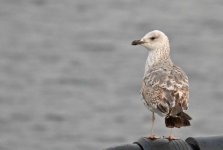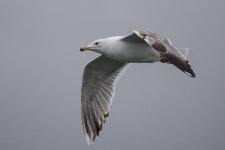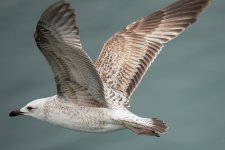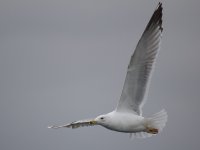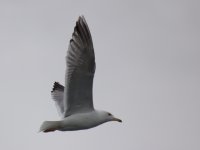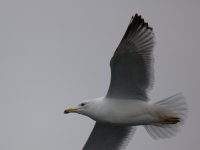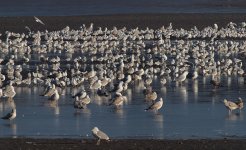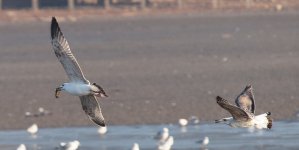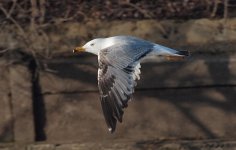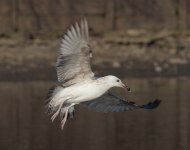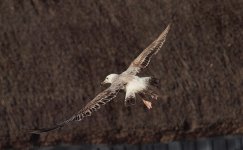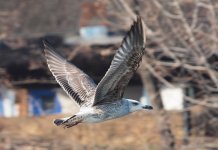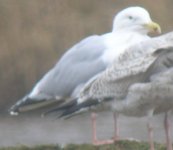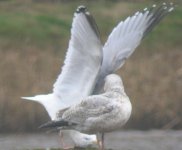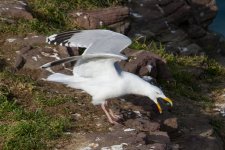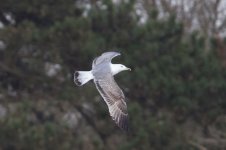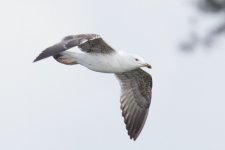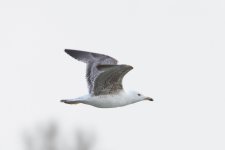-
Welcome to BirdForum, the internet's largest birding community with thousands of members from all over the world. The forums are dedicated to wild birds, birding, binoculars and equipment and all that goes with it.
Please register for an account to take part in the discussions in the forum, post your pictures in the gallery and more.
You are using an out of date browser. It may not display this or other websites correctly.
You should upgrade or use an alternative browser.
You should upgrade or use an alternative browser.
gulls (10 Viewers)
- Thread starter lou salomon
- Start date
More options
Who Replied?lou salomon
the birdonist
a retarded 3cy female type, maybe weak, michahellis. head shape amd striation are just fine for YLG. and there exist such retarded individuals.
edit: most scaps are 3rd gen. but not fully grey. could be this bird is a very advanced 1st cycle. if replaced almost all coverts and tertials in postjuvenile moult (GC-pattern looks like it definitley is 2nd generation, but they are already worn), this could well be a bird wit 1st gen. remiges and rectrices...
edit: most scaps are 3rd gen. but not fully grey. could be this bird is a very advanced 1st cycle. if replaced almost all coverts and tertials in postjuvenile moult (GC-pattern looks like it definitley is 2nd generation, but they are already worn), this could well be a bird wit 1st gen. remiges and rectrices...
Last edited:
Thanks lou ,I also think as same coverts and scapulars feathers. I was thought can be hybird with cach x mich , so that that scapulars is so patterned , in the other hand head shape thought it must be a mich. I didnt think can be weak one , have more thinks to learn , thanks.
Cheers.
Cheers.
lou salomon
the birdonist
weak birds often moult late or get retarded looking feathers. but as i said in the edited version, it might be a very advanced 2cy (1st winter) bird with a lot of 3rd gen. scapulars. this is not too uncommon, especially in southern breeders that hatch early in the year. two greek birds (michahellis) even had some primaries renewed in their first year!
cachinnans x michahellis is the least probable hybrid combination in european large gulls - or lets say the least known combo. in romania where both sp. breed close to each other hybridization seems to be no issue or at least there is very little interbreeding.
cachinnans x michahellis is the least probable hybrid combination in european large gulls - or lets say the least known combo. in romania where both sp. breed close to each other hybridization seems to be no issue or at least there is very little interbreeding.
lou salomon
the birdonist
1st one is a 3rd cycle (4cy) male caspian: long and heavy bill! tongues on underside of p10, p9. lacking p9 mirror is probably the minority in 3rd cycle cachs but occures with even smaller p10 mirrors in core breeding range. otherwise, aslo from pattern on upperwing this is quite a classic male 4cy cach.
2nd one definitely looks like a michahellis, more the eastern type. iris getting paler is a good pointer in early 2cy. this bird has a soft underwing pattern like some well patterned caspian gulls. but this one has well patterned greater coverts and quite bold patterned 2nd gen. lesser coverts.
2nd one definitely looks like a michahellis, more the eastern type. iris getting paler is a good pointer in early 2cy. this bird has a soft underwing pattern like some well patterned caspian gulls. but this one has well patterned greater coverts and quite bold patterned 2nd gen. lesser coverts.
Hi Lou , firstly thanks for your comment. Second picture I agree with you , but the first picture , I have questions. When I on watching this gull ' s bill seems to be short and strong black gonydeal band. The proportion is small than michahellis. We can see armenicus in the area. The aye have great area in the head. I put the other picture of this gull.
cheers.
cheers.
Attachments
lou salomon
the birdonist
the only strange thing about this is the very short p1o underside white tongue. this is unusual for cachinnans but it no way looks like a 4cy armenicus (which would have much more black in wingtip). some eastern cachinnans are said to show more black in wing and shorter tongues - if this is a barabenesis influence or not is not clear i guess. i would still call it a good male 4cy cachinnans  there seem to be some leucism going on in its "right hand" - looks stronger bleached and with some pseudo-"thayeri" pattern, another oddity in this bird.
there seem to be some leucism going on in its "right hand" - looks stronger bleached and with some pseudo-"thayeri" pattern, another oddity in this bird.
Last edited:
Cristian Mihai
Cristian Mihai
lou salomon
the birdonist
nice, cris, - any closeups  ?
?
Cristian Mihai
Cristian Mihai
I have some close up shots with three birds - you'll have to wait until tomorrow...
Cristian Mihai
Cristian Mihai
Herastrau - February 28th 2013.
1 - 2cy Caspian Gulls
2 - 3cy Yellow-legged Gull
3 & 4 - 2cy Caspian Gull
5 - 2cy Yellow-legged Gull (?)
1 - 2cy Caspian Gulls
2 - 3cy Yellow-legged Gull
3 & 4 - 2cy Caspian Gull
5 - 2cy Yellow-legged Gull (?)
Attachments
Last edited:
lou salomon
the birdonist
1 actually shows a 3cy caspian gull (left), note clearcut rel. large p10 tongue and white tips to inner primaries, and the other one is a 2cy, looks more like micha to me, but hard to ID from this pic.
all other birds are ID-ed and aged correctly. what a big brute this male 2cy cach is. and note the pale getting iris in the last micha (not happening in cachi).
cheers
all other birds are ID-ed and aged correctly. what a big brute this male 2cy cach is. and note the pale getting iris in the last micha (not happening in cachi).
cheers
Laurie93
Well-known member
lou salomon
the birdonist
hi laurie,
primary pattern excludes caspian and yellow-legged gull, this is a subadult (probably 4th cycle = 5cy if taken recently) herring gull. some HGs have the odd dark iris.
best
primary pattern excludes caspian and yellow-legged gull, this is a subadult (probably 4th cycle = 5cy if taken recently) herring gull. some HGs have the odd dark iris.
best
Tib78
Well-known member
A French Herring gull from the Cap Fréhel colony taken this week. Interesting primary pattern with more black on wingtip than expected from a typical argenteus, noticeable on P6 and especially P5 showing a complete black subterminal band. P9 mirror rather big as well. Comments welcome in case I missed anything (wouldn't surprise me, Gull ID is not my forte!) otherwise I guess that one will join the 'not typical but still a Herring' gallery...
Attachments
lou salomon
the birdonist
i think peter adriaens can tell you best the likeliness of p5-band argenteus. it seems to happen in both argentatus and teus, well known from eastern baltic birds but as i recall peter told they occure in teus-populations also. would be nice to see a ventral wing view for tongue shapes. thanks for sharing, tibault.
recently i was struggling with a similar problems with some record shots of puatative argentatus from romania, all with remarkable head striation in january, tatus-body structure and bare parts plus long cachi-like tongues plus a solid p5 mark - a combo that caused some headache.
recently i was struggling with a similar problems with some record shots of puatative argentatus from romania, all with remarkable head striation in january, tatus-body structure and bare parts plus long cachi-like tongues plus a solid p5 mark - a combo that caused some headache.
Tib78
Well-known member
Thanks for the feedback Lou.
No other pic unfortunately. To be honest I only noticed the peculiar primary pattern when reviewing the image on my camera screen a few minutes after I took it. And I failed to relocate the bird among the 50 or so adults also present. FWIW, thi individual did not stand out from the crowd, be it in terms of shape, mantle/bare parts colour or voice (I saw/heard it performing long call while landing, as can be seen on the picture).
No other pic unfortunately. To be honest I only noticed the peculiar primary pattern when reviewing the image on my camera screen a few minutes after I took it. And I failed to relocate the bird among the 50 or so adults also present. FWIW, thi individual did not stand out from the crowd, be it in terms of shape, mantle/bare parts colour or voice (I saw/heard it performing long call while landing, as can be seen on the picture).
Users who are viewing this thread
Total: 11 (members: 0, guests: 11)




